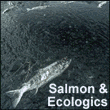forum
library
tutorial
contact

Study Details Salmonid Response to
Columbia River Basin Habitat Restoration Projects
by Staff
Columbia Basin Bulletin, January 10, 2025
|
the film forum library tutorial contact |

|
Study Details Salmonid Response to
by Staff
|
Shows Large Benefits for Coho, Steelhead
Floodplain restoration projects designed to improve instream habitat conditions for anadromous fish resulted in an increase in the numbers of juvenile salmon and steelhead, according to a recent study that examined segments of 17 habitat restoration projects in the Columbia River basin.
The habitat improvements benefitted all salmon and steelhead, but coho salmon and steelhead saw the largest increases in numbers, with an increase averaging 60 percent.
The study, which only included river reaches of mature habitat restoration projects alongside well-selected control reaches, also found increases in side channel metrics (area, length and the ratio of bank-full side-channel to main channel length), as well as sinuosity (more bends in the stream), pool frequency and presence of large wood, the study says.
"Our study found that floodplain restoration projects were successful at improving floodplain and instream habitat conditions and increasing numbers of juvenile salmon and steelhead," said Phil Roni, principal scientist at the Watershed Sciences Lab of Cramer Fish Sciences in Issaquah, WA. and the School of Aquatic and Fishery Sciences, University of Washington. "The most significant improvements were for numbers of juvenile steelhead and coho salmon which increase on average more than 60% following restoration."
More precisely, the study says that coho salmon abundance rose by a whopping 4.62 times more than in the control reaches, whereas steelhead abundance rose 1.62 times and Chinook salmon abundance rose just 1.17 times more than in control reaches. Combined salmon abundance (all salmon and steelhead combined) rose by 1.65 times. The study said that "these increases were only significant for steelhead and all salmonids combined."
"The large coho response to the floodplain restoration projects, despite the relatively low sample size, is expected given that juvenile coho strongly prefer pools, side channels, and floodplain habitats," the study says.
Roni said that, "Yes, coho had the highest response but they were only found at less than half the sites so the results weren’t statistically significant. The results for steelhead (which were found at nearly all the sites) and all of the species combined were the only statistically significant results -- this is largely due to sample size differences."
"Coho were only recently reintroduced to the Columbia River above Bonneville Dam, and their distribution and numbers will likely continue to increase," the study says.
The researchers expected a stronger response for juvenile Chinook salmon to the habitat improvement project.
"There were slightly higher numbers of juvenile Chinook in treatment compared to control reaches on average, but the differences were not significant and were highly variable among sites," the study says. "The lack of significant responses may be due to a variety of project level factors including sample size (Chinook were present at only 13 sites); time since restoration at some sites; the variability in types and intensity of restoration."
Still, "Chinook response was positively correlated with floodplain to main channel and percent of slow water habitat, which is expected given their preference for slow water habitats," the study says.
The study said that a larger sample size (the researchers sampled 17 sites) would have been helpful to more adequately compare different types of restoration. "Given the increased emphasis on floodplain restoration, this will likely become possible in the future," it said.
In addition to the abundance results, Roni said the study demonstrated that using a combination of remote sensing (drone-based LiDAR) and field data can be used to efficiently monitor floodplain restoration projects.
"The methods we developed are being used to evaluate larger floodplain restoration projects -- which have been increasing in size and complexity in recent years and can’t be monitoring effectively with traditional field-based approaches to monitoring and evaluation," Roni said.
The restored sites used in the study ranged from two to 14 years old, with a median of four years, Roni said. Sometimes it can take several years for a site to fully respond to restoration, he added.
"Evaluation of floodplain restoration projects in the interior Columbia River basin using a combination of remote sensing and field data" was published Dec. 6, 2024, in the Canadian Journal of Fisheries and Aquatic Sciences.
Researchers are Roni; Shelby Burgess, senior biologist, Watershed Sciences Lab of Cramer Fish Sciences and the School of Aquatic and Fishery Sciences, U of W; Kai Ross, senior biometrician, Watershed Sciences Lab of Cramer Fish Sciences; Chris Clark, senior biologist, Bureau of Land Management; Jake Kvistad, biometrician, Washington Department of Fish and Wildlife; Michelle Krall, senior biologist, King County Water & Land Resources Division; Reid Camp, senior geomorphologist, Watershed Sciences Lab of Cramer Fish Sciences; Alex Arams, biologist, Watershed Sciences Lab of Cramer Fish Sciences; Meghan J. Camp, senior scientific writer, School of the Environment, Washington State University and Upper Columbia Salmon Recovery Board.
Note these were the researchers’ positions when they worked on the project -- some have taken new jobs and have new titles, Roni said.
Related Pages:
Cleaning Up Columbia River Oil Spill Could Take Weeks by Staff, Greenwire, 1/23/18
Astoria Oil Spill Cleanup Could Take Weeks by Anna Marum, The Oregonian, 1/22/18
Largest Columbia River Estuary Restoration Project Completed by KC Mehaffey, NW Fishletter, 1/31/22
Feds: Tidegate Protecting Farmland Jeopardizes Salmon, Killer Whales by Don Jenkins, Capital Press, 8/23/24
Feds See Second Skagit Tidegate Repair as Threat to Salmon, Killer Whales by Don Jenkins, Capital Press, 9/9/24
learn more on topics covered in the film
see the video
read the script
learn the songs
discussion forum
